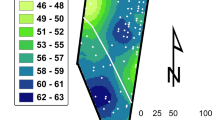Abstract
Advanced wireless irrigation sensor networks that can monitor and control irrigation are only recently available commercially, but on-farm research has found a number of advantages compared with current irrigation practices including reduced water application, disease incidence, production time and labor, together with increased profitability. We examined the effects of wireless sensor networks to precisely control irrigation based on substrate moisture in a 0.15-ha greenhouse producing cut-flower snapdragons (Antirrhinum majus). We calculated changes in yield, production time, quality, cost, revenue and profit using grower data on production, expenditures and sales, which included 3 years of data before and after implementation of sensor irrigation networks. Sensor-based irrigation was associated with a 62 % ($65,173 or $434,487 ha−1) increase in revenue and a 65 % ($35,327 or $325,513 ha−1) increase in profit per year. Sensor-based irrigation was also associated with increases in the quality and the number of stems harvested per crop. The time to first harvest and time to last harvest were reduced for all cultivar groups, indicating that the plants grew faster using sensor networks. Production time per crop was decreased, allowing 2.5 additional crops per year. Electricity usage was also reduced, likely due to less frequent irrigation using sensor networks. These results are in line with other benefits we have seen by installing sensor networks in other types of ornamental operations.







Similar content being viewed by others
Notes
The grower briefly varied plant density to increase yields, but discontinued changes in density after they did not appreciably increase marketable yield.
There were 3 weeks in which harvests contained both plants that used sensors and plants that did not. For all other weeks, the sensor variable is binary.
References
Ackerman F, Stanton E (2011) The last drop: climate change and the southwest water. CrisisRep., Stockholm Environment Institute, Stockholm
Beeson RC Jr, Haydu J (1995) Cyclic microirrigation in container-grown landscape plants improves plant growth and water conservation. J Environ Hortic 13(1):6–11
Belayneh BE, Lea-Cox JD, Lichtenberg E (2013) Costs and benefits of implementing sensor-controlled irrigation in a commercial pot-in-pot container nursery. HortTechnology 23:760–769
Beeson RC, Arnold MA, Bilderback TE, Bolusky B, Chandler S, Gramling HM, Lea-Cox JD, Harris JR, Klinger PJ, Mathers HM, Ruter J, Yeager TH (2004) Strategic vision of container nursery irrigation in the next ten years. J Environ Hortic 22:113–115
Brennan D (2008) Factors affecting the economic benefits of sprinkler uniformity and their implications for irrigation water use. Irrig Sci 26:109–119
Cabrera RI, Evans RY, Paul JL (1993) Leaching losses of N from container-grown roses. Sci Hortic 53:333–345
Chappell M, Dove SK, van Iersel MW, Thomas PA, Ruteret J (2013) Implementation of wireless sensor networks for irrigation control in three container networks. HortTechnology 23:747–753
Chen J, Huang Y, Caldwell RD (2001) Best management practices for minimizing nitrate leaching from container-grown nurseries. In: Optimizing nitrogen management in food and energy production and environmental protection. Proceedings of 2nd international nitrogen conference on science and policy. Sci World 1(S2):96–102
Daum D, Schenk MK (1996) Gaseous nitrogen losses from a soilless culture system in the greenhouse. Plant Soil 183:69–78
Evans RG, LaRue J, Stone KC, King BA (2013) Adoption of site-specific variable rate sprinkler irrigation systems. Irrig Sci 31:871–887
Groffman PM, Tiedje JM (1991) Relationships between denitrification, CO2 production and air-filled porosity in soils of different texture and drainage. Soil Biol Biochem 23(3):299–302
Hall CR, Hodges AW, Palma MA (2011) Sales, trade flows and marketing practices within the U.S. nursery industry. J Environ Hortic 29:14–24
Lichtenberg E, Majsztrik J, Saavoss M (2013) Profitability of sensor-based irrigation in greenhouse and nursery crops. HortTechnology 23(6):770–774
Myrold DD, Tiedje JM (1985) Establishment of denitrification capacity in soil: effects of carbon, nitrate and moisture. Soil Biol Biochem 17(6):819–822
Parke JL, Grunwald NJ (2012) A systems approach for management of pests and pathogens of nursery crops. Plant Dis 96(9):1236–1244
Ristvey AG, Lea-Cox JD, Ross DS (2004) Nutrient uptake, partitioning and leaching losses from container-nursery production systems. Acta Hortic 630:321–328
Ross DS, Lea-Cox JD, Teffeau KM (2002) The importance of water in the nutrient management process. Proc South Nurs Assoc Res Conf 46:574–577
Sauer T, Havlik P, Schneider UA, Scmid E, Kindermann G, Obersteiner M (2010) Agriculture and resource availability in a changing world: the role of irrigation. Water Resour Res 46:W06503. doi:10.1029/2009WR007729
Schaible G, Aillery M (2012) Water conservation in irrigated agriculture: trends and challenges in the face of emerging demands. Economic Information Bulletin EIB-99, Economic Research Service, U.S. Department of Agriculture
US Department of Agriculture (2009) Census of Agriculture: United States Summary and State Data, Washington, DC
van Iersel M, Seymour RM, Chappell M, Watson F, Dove SK (2009) Soil moisture sensor-based irrigation reduces water use and nutrient leaching in a commercial nursery. SNA Research Conference, Atlanta, GA, S. Nursery Association
Acknowledgments
The authors gratefully acknowledge funding support for this project from USDA–NIFA Specialty Crops Research Initiative; Award #2009-51181-05768. We thank Charles and Richard Bauer for their assistance with conducting this experiment and providing historical production, sales and expenditure data.
Author information
Authors and Affiliations
Corresponding author
Additional information
Communicated by J. Knox.
Rights and permissions
About this article
Cite this article
Saavoss, M., Majsztrik, J., Belayneh, B. et al. Yield, quality and profitability of sensor-controlled irrigation: a case study of snapdragon (Antirrhinum majus L.) production. Irrig Sci 34, 409–420 (2016). https://doi.org/10.1007/s00271-016-0511-y
Received:
Accepted:
Published:
Issue Date:
DOI: https://doi.org/10.1007/s00271-016-0511-y




